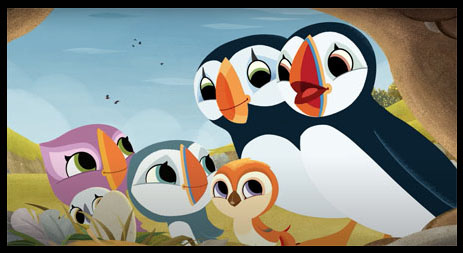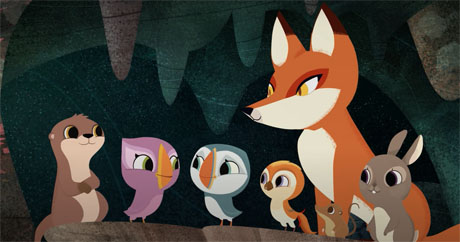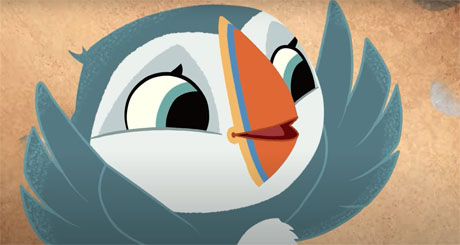
Cartoon Saloon, the animation house behind The Secret of Kells, The Breadwinner and Wolfwalkers, is unveiling its latest feature. Puffin Rock and the New Friends — a continuation of the popular TV series — is available to rent or purchase on Google TV, Amazon Prime Video and Apple TV beginning Tuesday April 16th. Director Jeremy Purcell and animation director Lorraine Lordan share how the movie took flight — and how it fits right in line with Cartoon Saloon’s mission — in this Animation Scoop Q&A. (This interview was edited for length and clarity.)
Jackson Murphy: Congratulations on the movie. I think it’s so sweet. I think families are gonna enjoy it. And this is a feature film adaptation / continuation of the popular Puffin Rock TV series. Jeremy, you were the assistant director on that. How did it feel jumping back into this world and these characters?
Jeremy Purcell: Great. Puffin Rock within the studio is such a loved production and people love working on it. I was assistant director on it and very happily jumped back into the movie. Lorraine was the animation director on season two. We had three or four or five people, I think, who had worked on the TV series who were very happy to kind of jump back into the movie.

Lorraine Lordan: Yeah, there was a lovely thing from the TV series to the feature film where a lot of artists who maybe got their first job on the series actually stepped up like myself — I was animation director on the TV show. And I was assistant director and I got to direct a sequence of the film, which is the flashback for Isabel. So I got to broaden my range, and we had a couple of artists… their very first job in the industry was Puffin Rock the TV show. And then they got to step up and be supervisors on the feature film. They all said how lovely it was to come back and come full circle and round out this kind of movement of their career as well as their just love of the show.
JM: That’s amazing. That’s really nice. I remember when I was in fourth grade and I learned a lot in science class about puffins. I’ll never forget it. One of my favorite experiences from elementary school science. Lorraine, what do you love so much about puffins?
LL: It’s interesting. It’s challenging in a way that maybe other TV shows aren’t because we really take a very naturalistic approach. We don’t make our animals look like humans or move like humans. It’s important to us. We do a lot of research about how they live and move in the natural world. We do take obviously a little bit of artistic license. But none of our characters have hands. And so we do have challenges that maybe other cartoons don’t, that would maybe have more humanoid characters. We actually do a lot of research into all of the habits and the way that they do things. And then we try and introduce that. Our lovely narrator kind of expands on the information and really makes it such an easy way to absorb some science and nature facts.

Director Jeremy Purcell and animation director Lorraine Lordan
JM: The educational component to this is terrific, and I think kids are going to get so much out of it. And you’re right about the narration. Chris O’Dowd is a very talented actor and comedian. What I love about his narration in this movie is that he’s very present. He is an active participant in what’s going on. How was it collaborating with him?
JP: He was really great because he has his own children of that age. So he knows exactly what we really wanted to get with it. With the narrator — he’s a father at night reading a story to his children. So you know what’s coming up and you can be emotionally involved and you can be portraying that excitement to the children or the sadness or anything like that as they’re reading that book. So we wanted to try and carry that into a movie version of him. And I think he works really great in it.
LL: I think another aspect of it that’s really nice is that he kind of asks the questions that we want to ask or he says the things that we want to say. I think that’s a really nice thing because it gives the audience a voice.
JP: We’ve had a couple of screenings that we’ve attended. We’ve actually had those audiences shout out… at particular moments of “No! It’s not happening. It’s not him!”
LL: But that’s the lovely thing of watching something like this with children. They’re so engaged and they’re so passionate about it as well.
JM: I’m glad that they liked the film and that they’re invested in these characters like Una. She goes on quite the journey, along with new friends like Isabel and Marvin. So how did you want to approach this story — giving these characters the ability to have these epic situations, sometimes intense situations, and allow them to grow?
LL: We thought about what children of that age might deal with. On a smaller scale, it might be something like you’re changing schools and you’re leaving all your friends behind and you have to make new friends, and it’s a really daunting situation. And then on a bigger scale, you might have to move country or across state lines or something like that. There’s bigger challenges in the world as well that face many kids these days. But we wanted to be a story that could be as big or small as your world, in a way. So we have three new friends that arrive on Puffin Rock. And in a way, they’re all facing the same challenge. They’re all arriving in a new place and they’ve got to make friends. They’ve got to try and adjust. And the thing that we really took into account is their different personalities meant that they’re going to react to the same situation in a totally different way. And what we were really hoping to achieve with the story of that is that kids might understand, not only the kids that are moving, but the kids that are receiving these new visitors, that they can empathize with what they’re going through and the challenges that they’re facing, and that maybe they can be in a better position to be understanding and to help these new kids make that adjustment.

JM: There are a lot of great themes and messages about friendship, meeting new friends and working together as a team. A lot of the movie is about protecting an egg and protecting your family. You have to protect these characters. These are beloved for fans who watch the TV show. Did you feel sort of a pressure in that same sort of way, parallel to the story that’s going on?
JP: Definitely. (Laughs) Yes, definitely a lot of pressure. They are beloved characters and we knew that would get like going from a TV series, which are maybe seven minute episodes, six minute episodes, going up to a movie… we really wanted this to be like a first movie experience, either in the cinema or at home for children. But we wanted it to be a Puffin Rock experience. That was most important rather than just, “Oh, let’s make a movie and we can do it in 3D.” We didn’t want to leave the world of the TV series behind. So it very much still is a Puffin Rock world — a Puffin Rock experience, just a longer story, maybe a bit more involved than some of the stories from the TV series.
LL: Even though in some places in the film you need some conflict and we do add up the stakes a little bit, we’re very aware of our audience. We’re very aware of what they can manage. We never leave you in jeopardy for too long because it is a young audience. It’s possibly younger than a lot of the films that we make here. So there is that awareness of who’s watching this and what we want to tell them and how much we want to scare them. We want them to think about things, but we don’t want them to ever be anxious afterwards.
JM: There are very pretty daytime sequences and there are very cool looking nighttime sequences and some of those intense moments, but obviously not too intense for the audience you’re going after. What would you say was more challenging, the daytime or the nighttime?
LL: I guess the night, but mainly the storm. Weather is a big challenge for our teams. We start planning for those big sequences very, very early along because they are going to take a little bit longer. So we start them a little bit earlier and finish them a little bit later. And so those were the things where we took that extra time, we tried loads of things out as well before we got there because it was not something that we had seen before in the TV show — those big epic storms.

JM: Cartoon Saloon turns 25 this year. How does it feel for this studio to be a quarter of a century old?
JP: (laughs) I joke with people — both myself and Lorraine joined the studio in the last century. It was 1999 when we joined the studio. And we have this kind of running joke in the studio of, “Once you come to Cartoon Saloon, you never really leave.” You might, you might go and work somewhere else for a while. But you will come back again. So this is actually my third time being back in the studio. So I’ve been here for almost the full 25 years. It’s honestly great. We started out in a two-room kind of studio at desks. We had a drawing room and a computer room. Everybody was working on paper at the time. So we’ve grown in that digital age of going from paper all the way through to something like Puffin Rock or other movies and TV shows that we work on now are almost fully, entirely digital.
LL: It’s been a huge journey for the studio and for us. To be along on the journey as well, we feel really, really privileged. The studio is nurturing more talent coming in all the time. We love working with new people. We’ve gone from drawing with pencil and paper to everything in a computer and the technology has changed. But, in some ways, it’s exactly the same. We’re still looking at the story. We’re still looking at the visuals. We’re still listening to the voices. Some things don’t change.
JP: The conversations that we had 25 years ago with Nora, Tom and Paul and, and Ross Church and Fabian and other people was still about the artwork and about the story and about the look. It’s still the same conversations now. We just get to maybe do it a little bit quicker than we did back then. But yeah, it’s still exactly the same conversations.
- INTERVIEW: Jeff Fowler On “Knuckles” And “Sonic 3” - April 22, 2024
- INTERVIEW: “Inside Out 2” Director And Producer On Pixar Sequel - April 16, 2024
- INTERVIEW: “Puffin Rock And The New Friends” And 25 Years Of Cartoon Saloon - April 10, 2024


 April 10th, 2024
April 10th, 2024  Jackson Murphy
Jackson Murphy  Posted in
Posted in  Tags:
Tags: 






